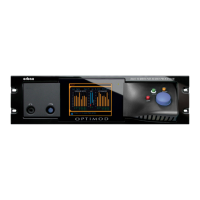OPTIMOD SURROUND PROCESSOR OPERATION
3-11
enhancing bright material. It interacts synergistically with the five-band compressor
to produce sound that is bright and present without being excessively shrill. It can
help improve dialog intelligibility. It is gated so that it does not amplify the program
material’s noise floor.
The equalizer section is mostly useful for “radio-style” processing and applications.
For television applications, it is usually left flat.
Multiband Compressor/Limiter
The multiband compressor/limiter can be operated in five-band or two-band mode.
In five-band mode, each band compressor has a K
NEE and RATIO control. A soft knee
and gentle ratio are particularly useful in production and mastering applications, al-
lowing subtle compression that retains as much of the dynamics of the input pro-
gram material as the operator desires. These features are also exploited in the TV
2B
DRAMA and TV 5B DRAMA presets.
Several band-coupling controls allow the gain reduction of a given band’s compres-
sor to be affected by the gain reduction in its neighboring band’s compressor. These
coupling controls allow anything from quasi-wideband compression to fully inde-
pendent multiband compression.
A clipper, embedded in the crossover, protects bands 1 and 2 from transient over-
shoot. This clipper has a shape control, allowing you to vary the “knee” of its in-
put/output transfer curve from hard (0) to soft (10).
Each band in the 2.0 multiband compressor has two sidechains—one for the left and
one for the right channel. You can separately set the left/right coupling of each
band anywhere from 100% stereo coupled to fully independent.
The surround multiband compressor is always stereo coupled and has two main
sidechains.
• The first surround sidechain responds to the power (r.m.s.) sum of all channels.
However, to prevent sibilance in the center channel from ducking high frequen-
cies in the remaining channels, the center channel does not affect the gain re-
duction in bands 4 and 5.
As in the AGC, the S
URROUND OPTIMIZATION control for the active preset deter-
mines how the rear channels are weighted in the r.m.s. sum.
This sidechain applies the slow “compression” component of the gain reduction
identically in all channels except for the center. However, each channel also has
an individual “limiting” function that is not stereo coupled. This prevents fast
transients in one channel from audibly modulating the gains of the other chan-
nels. Because this “limiting” function operates quickly, it does not affect stereo
imaging.
Do not confuse this “limiting” function with the 8685’s look-ahead lim-
iter, which is located after the Loudness Controller in a given processing
chain and which has much faster attack and release times.

